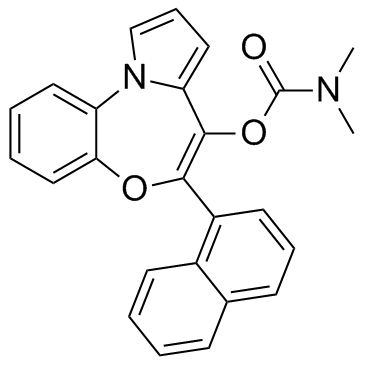| Description |
PBOX 6 is a pyrrolo-1,5-benzoxazepine (PBOX) compound, acts as a microtubule-depolymerizing agent and an apoptotic agent.
|
| Related Catalog |
|
| Target |
Apoptosis[1], Microtubule[3]
|
| In Vitro |
PBOX 6 is a potent apoptotic PBOX, but does not elicit a general toxic effect in a rat R2C Leydig cell line. PBOX 6 (0-25 μM, 16 h) results in dose- and time-dependent induction of apoptosis, and also causes DNA fragmentation at 10 μM in HL-60 cells. PBOX 6 (10 μM) induces apoptosis through activation of caspase 3-like proteases in HL-60 cells. PBOX 6 (10 μM) induces apoptosis and exerts an accumulation of cytochromec in the cytosol, but this effect is not triggered by oxidative stress, and is independent of peripheral-type benzodiazepine receptor (PBR) and NF-κB[1]. PBOX 6 (25 μM) induces apoptosis in MCF-7 cells through activation of caspase-7[2]. PBOX 6 (10 μM) induces the redistribution of cypA from the nucleus to the cytosol of the cell in K562 cells. PBOX 6 (10 μM) induces nucleocytoplasmic redistribution of cypA and pin1 through a JNK-dependent manner, also dependent on upstream activation of a trypsin-like serine protease, and this effect correlates with G2/M arrest in K562 cells[3].
|
| Cell Assay |
Cells are seeded at a density of 3 × 105 cells/mL and following treatment with the indicated compound (including PBOX 6), an aliquot (100 μL) is cytocentrifuged onto glass slides precoated with poly(l-lysine). They are then stained with the RapiDiff kit (eosin/methylene blue). The degree of apoptosis and necrosis is determined by counting 300 cells under a light microscope. At least three fields of view per slide, with an average of 100 cells per field, are counted and the percentage of apoptosis and necrosis is determined. Apoptotic cells are characterized by cell shrinkage, membrane blebbing, and nuclear condensation and fragmentation, whereas necrotic cells are identified by cell swelling and loss of cell membrane[1].
|
| References |
[1]. Zisterer DM, et al. Pyrrolo-1,5-benzoxazepines induce apoptosis in HL-60, Jurkat, and Hut-78 cells: a new class of apoptotic agents. J Pharmacol Exp Ther. 2000 Apr;293(1):48-59. [2]. Mc Gee MM, et al. Caspase-3 is not essential for DNA fragmentation in MCF-7 cells during apoptosis induced by the pyrrolo-1,5-benzoxazepine, PBOX-6. FEBS Lett. 2002 Mar 27;515(1-3):66-70. [3]. Bane FT, et al. The microtubule-targeting agents, PBOX-6 [pyrrolobenzoxazepine 7-[(dimethylcarbamoyl)oxy]-6-(2-naphthyl)pyrrolo-[2,1-d] (1,5)-benzoxazepine] and paclitaxel, induce nucleocytoplasmic redistribution of the peptidyl-prolyl isomerases, cyclophilin A and pin1, in malignant hematopoietic cells. J Pharmacol Exp Ther. 2009 Apr;329(1):38-47.
|
